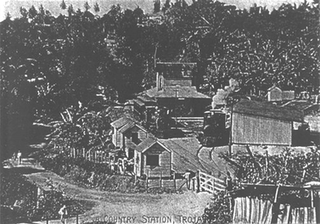Transport in Jamaica consists of roadways, railways, ship and air transport, with roadways forming the backbone of the island's internal transport system.

Montego Bay is the capital of the parish of St. James in Jamaica. The city is the fourth-largest urban area in the country by population, after Kingston, Spanish Town, and Portmore, all of which form the Greater Kingston Metropolitan Area, home to over half a million people. As a result, Montego Bay is the second-largest anglophone city in the Caribbean, after Kingston.

Pakistan Railways is the national, state-owned railway company of Pakistan with its headquarters in Lahore. Founded in 1861 as the North Western State Railway and headquartered in Lahore, it owns 7,789 kilometres of operational track across Pakistan, stretching from Peshawar to Karachi, offering both freight and passenger services, covering 505 operational stations across Pakistan.

The Stony Point line is a greater-metropolitan commuter railway line in the city of Melbourne, Victoria, Australia. Operated by Metro Trains Melbourne, it is the city's only diesel service on the metropolitan network and the tenth longest line at 31 kilometres (19 mi). The line acts as an extension of the Frankston line with services running from Frankston station to the small town of Stony Point in the south-east, serving 10 stations via Leawarra, Baxter, Hastings, and Bittern. The line operates for approximately 13 hours a day, unlike other lines on the network, which provide 24-hour service on Friday and Saturday nights. Headways of 90 to 120 minutes are operated throughout the day due to limited patronage and infrastructure constraints. Trains on the Stony Point line run as two one-car formations of V/Line Sprinters.

Canberra railway station is located on the NSW TrainLink Regional Southern Line in the Australian Capital Territory, Australia. It is located in the Canberra suburb of Kingston.
The Kingston to Montego Bay railway was the main railway in Jamaica, which from 1845 to 1992 linked the capital Kingston with the second city Montego Bay, passing en route most of the major towns.
The Spanish Town to Ewarton railway was a railway in Jamaica, built to serve the citrus growing regions in the interior of Saint Catherine, particularly those around the towns of Bog Walk, Linstead and Ewarton. It operated from 1885 to 1992.
The roads in Jamaica allow people and goods to traverse the island of Jamaica, which is the third largest in the Caribbean. As of 2011, Jamaica has road network 22,121 kilometres in length.
Balaclava is a small town in Northern St Elizabeth parish, Jamaica. It used to be an important town in the north of the parish.

Alfred County Railway is an abandoned 2 ft narrow gauge railway in South Africa, which runs from the southern transport hub of Port Shepstone on the Indian Ocean, via Izotsha and Paddock for 122 kilometres (76 mi) to Harding, KwaZulu-Natal.

Kingston railway terminus was built in the Jamaica Georgian architectural style using brick. It was constructed on a grand scale, symbolising its importance as the main terminus of the Jamaica railways. It has prominent arcades on both levels of the east entrance end. Victorian cast iron brackets support the roof overhang on the trackside. It has sash windows on the ground and upper floors.

Spanish Town railway station opened in 1845 and closed in 1992 when all passenger services in Jamaica abruptly ceased. It provided rail services to Kingston and Montego Bay, Port Antonio, Ewarton and New Works. It was 11.75 miles (18.91 km) from the Kingston terminus. It is on the list of designated National Heritage Sites in Jamaica.

Montego Bay railway station opened in 1894 and closed in 1992 when all passenger services in Jamaica abruptly ceased. It served the Kingston to Montego Bay main line with branches from May pen to Frankfield, Spanish Town to Ewarton, Bog Walk to Port Antonio and Linstead to New Works. It was 112.75 miles (181.45 km) from the Kingston terminus.
Balaclava railway station opened in 1892 and closed in 1992. It served the small town of Balaclava on the Kingston to Montego Bay line and was 70.5 miles (113.5 km) from the Kingston terminus.

Albany railway station opened in 1896, closed in 1975, reopened in 1977 and closed for good in 1978. It was on the Bog Walk to Port Antonio branch line, 42.5 miles (68.4 km) from the Kingston terminus, and served the surrounding agricultural community, providing a means for bananas to reach and be exported from Port Antonio. It was destroyed by fire sometime after closure.

Troja railway station opened in 1896, closed in 1975, reopened in 1977 and closed for good in 1978. It was on the Bog Walk to Port Antonio branch line, 31 miles (50 km) from the Kingston terminus, and served the surrounding agricultural community, providing a means for bananas to reach and be exported from Port Antonio. It was vandalised some time after closure.
Ewarton is a town in the parish of Saint Catherine, Jamaica.
Ailford's halt opened in c1894 and closed in 1992. It was on the Kingston to Montego Bay line, 106.75 miles (171.80 km) from the Kingston terminus, and served the surrounding agricultural community.













